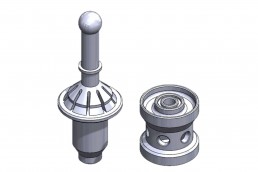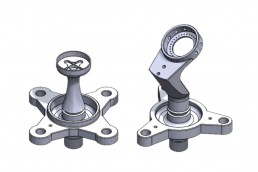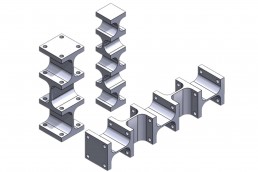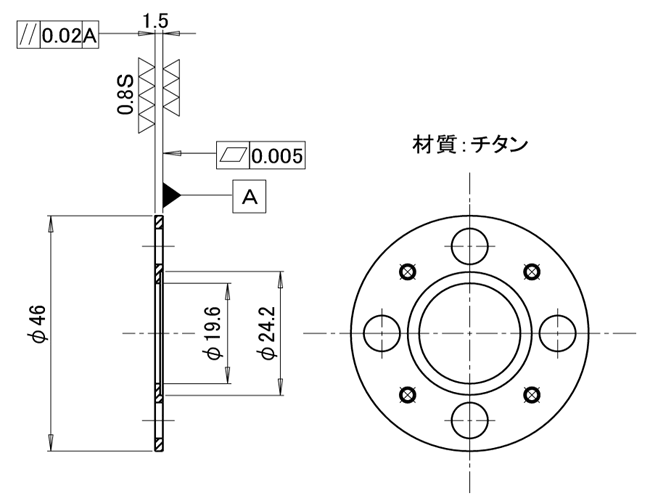Results of hard-to-machine materials processing
We process special materials that are resistant to temperature changes and/or complex shapes to achieve the customers' particular requirements for high strength and high precision.
We also specialize in processing materials such as the SUH660 that require heat resistance and high temperature strength.
We can manufacture from a single item.
Titanium (Ti)
Titanium is used in aircraft, rockets, automobiles, medical equipment, and marine parts as it is more corrosion resistant than stainless steel, has a specific gravity of half that of steel, and is as strong as steel. Its workability is not that good, however, we have wide processing experience and are good at grinding and lapping with high precision.
Tantalum
Tantalum is corrosion resistant, has a higher melting point than other materials, and is heat resistant. It is, on the other hand, brittle and difficult to process.
Material Properties
- Corrosion Resistance : Very high
- Melting point of 3000°C and heat resistance
- Non-magnetic, acid resistance
Molybdenum
Molybdenum has corrosion resistance and a higher melting point than other materials (heat resistant), however, it is brittle and difficult to process. Mirror finishing is also available.
Material Properties
- heat resistant
- Melting point of 2600°C
- brittle
Magnetic materials
It is used for solenoid valves and pole pieces. It is not hard, but it is sticky and easy to chew.
Material Properties
- Sticky
- Rusty
purpose
- Electromagnets, iron core
- Solenoid valves
- Pole pieces
Pure copper
Pure copper is one of the most difficult copper-based materials to process. It is a high-purity copper with few impurities and has excellent electrical and thermal conductivity and ductility.
Material Properties
- High purity copper with low impurity content
- Excellent electrical and thermal conductivity and ductility
purpose
- For electrical and chemical industries
- Mainly for electron tubes, etc.
- Electronic equipment materials
Nickel alloy
Various types of nickel alloys have been developed by material manufacturers, and while their workability varies, they are also prone to work hardening, making them troublesome and annoying for processors. They excel in heat resistance, oxidation resistance, and corrosion resistance, and can be used in a variety of applications. Recently, there has been a lot of demand for this material and we have become used to process difficult shapes.
Types/lines
- Permalloy
- Hastelloy
- Low thermal expansion alloys
- Inconel
- Invar
- Vasperoy
Material Properties
- Heat, oxidation and corrosion resistance
- Low thermal conductivity
purpose
- Jet engines
- Nuclear power related components
- Chemical plant parts
Cemented carbide
Cemented carbides are very hard (HV1000-1800) and have high wear resistance and are used for blades and wear resistant parts. We also process Sintered Tungsten Carbide with high precision by grinding, wire, electric discharge machining, and jig grinding.
Material Properties
- High wear resistance (HV 1000-1800)
- High hardness
purpose
- Edged tool
- Wear-resistant parts
heavy metal
Heavy metal is a very heavy material with a specific gravity of 1.5 times that of lead. It is used as a shielding material and balancing weight, taking advantage of its characteristics of corrosion resistance, radiation absorption, high density and high thermal conductivity. It is not easy to process, but we have some results. It is difficult to grind, but we have processed it in several cases.
Material Properties
- Excellent corrosion resistance and radiation absorption properties
- High density, high thermal conductivity
- Specific gravity is 1.5 times that of lead
- Low thermal expansion (1/2 that of steel)
purpose
- High energy beam shielding material
- Balance weight
Stainless steel
There are four types of stainless steel. Among austeniticstainless steel, SUS304 is widely used for food and automotive aplications. Martensitic stainless steel is quenched to be used. Precipitation hardening stainless steel is widely used in the aircraft industry. Although its workakbility is not good, we are able to cut, polish, and lap.
| Material Properties | purpose |
|---|---|
| Austenitic stainless steel SUS304 Non-magnetic SUS316 |
Food products and automotive construction materials |
| Ferritic stainless steel SUS430 |
Home appliances and construction |
| Martensitic Stainless Steel Hardening is possible SUS 420J2 SUS 440C |
Blades, bearings |
| Precipitation hardening stainless steel SUS 630 SUS 631 |
Aircraft Parts |
| Machinability rate: 30-60 | |



